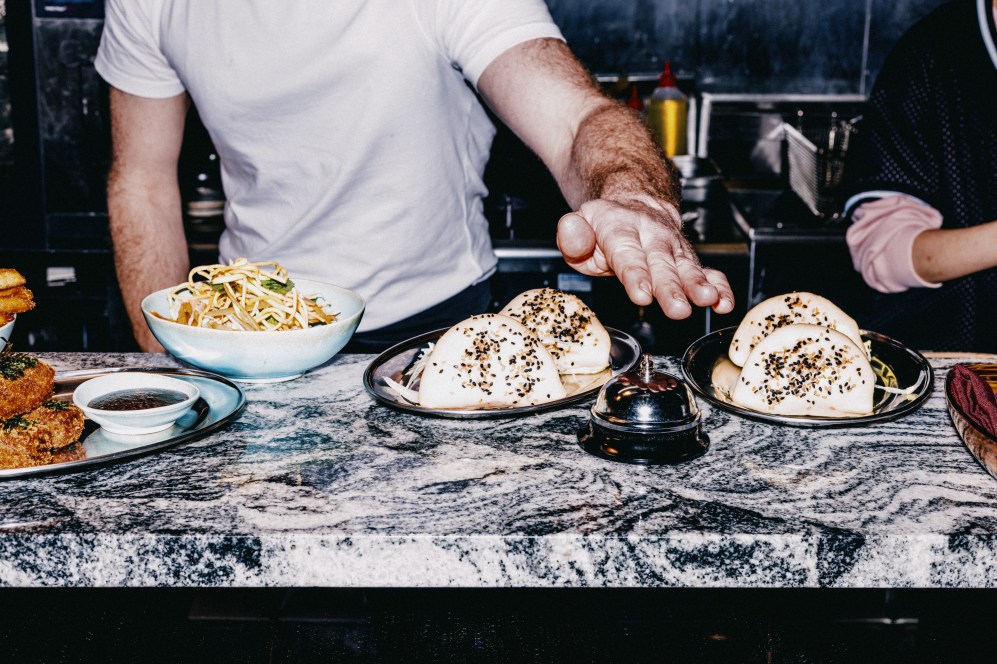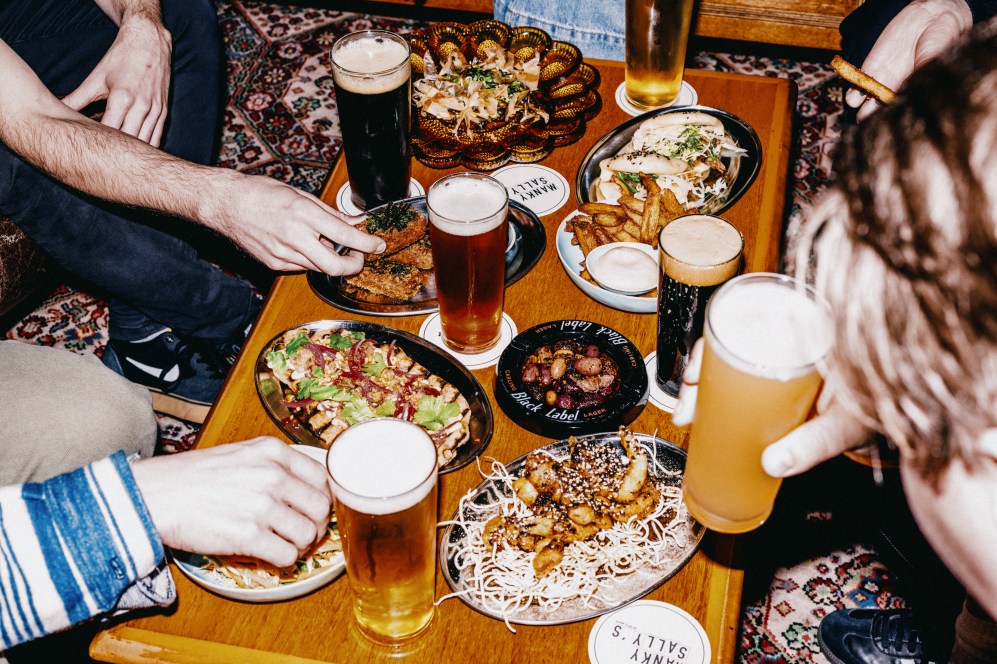Sam Bray has always been food-driven — his mum was a home ed teacher and his free time was spent in front of the television with his nanna watching Huey and Geoff Jansz. “I was a little fatty as a kid — there were good cooks everywhere,” he says.
In high school, Bray decided he wanted to be a chef or a cheesemaker, ultimately choosing the former. “I don’t have the attention span to be a cheesemaker, so I did an apprenticeship after high school and went from there.” The apprenticeship would take him across the country and abroad to one of the world’s most recognisable fine diners, Noma.
Now, you’ll find Bray in Hobart heading up the kitchen of MONA’s nano brewery/taphouse Manky Sally’s. The chef speaks to Hospitality about returning to familiar digs, developing a concept from the ground up, putting sustainability first, and winning the Tranche Scholarship.
Sam Bray started his career in an Italian kitchen before moving to the now-shuttered Spice Bar where he worked alongside Chef Aaron Ruttan. It was a fortuitous stint that led to the discovery that “restaurants could be really nice places to work” and the meeting of co-owner Kym-Sarah Ruttan, who knew one of the restaurant managers at Rene Redzepi’s Noma in Copenhagen.
“It was the best restaurant in the world at the time and Kym said I should go after I finished my apprenticeship,” says Bray. “I was 20 years old at the time and I started saving all my pennies — working in Copenhagen for free was a very expensive thing to do.”
Bray spent two months staging at Noma, but realised he wanted to take a different path — one that was quite different to his initial projections when he arrived at the restaurant. “I wanted to be in the uber fine dining world, but when I got there, it wasn’t that much fun,” he says. “The food was beautiful, and everyone was driven and passionate, but I like surfing and having a life. They all seemed a bit stressed.”
All being said and done, it was a rewarding and worthwhile couple of months. “It was an amazing experience and lined me up with every job I had afterwards, they all flowed on one from the other.”

London was next, before the grey got to him and Bray moved to Canada. “Vibrant cities are fun, but I need nature in my life, which is how I ended up in Tassie,” he says. The chef joined the team at MONA, working full-time for a few years before returning in a part-time capacity so he could fulfil another line of work. “I cracked the shits with being a chef and ended up doing multi-day bushwalking tours as a guide.”
But Bray didn’t hang up his apron for good and worked at the Heavy Metal Kitchen during Dark Mofo in winter. The MONA team were dedicated to getting Bray back in the kitchen full-time, and eventually, the chef was presented with an opportunity he
couldn’t turn down.
“The food and beverage director Pip Anderson had been trying to loop me back in for years and told me they were going to open a taphouse,” says Bray. “She introduced me to Lauren Sheppard from Moo Brew, and they talked me into it — it was too good to pass up.”
Bray joined Manky Sally’s in the early stages of development when the venue on Salamanca Place was nothing more than a concrete shell. The beer-first culinary brief was no issue for Bray, who says the beverage is much easier to work with than wine as you can go hard on the spice, crunch, and salt. “Massive flavours make beer pop, so I looked to what produce was around me and built dishes from there,” he says. “We are part of the MONA world, so we need to be different. We have ended up with a wine bar approach to the food.”
MONA’s ethical guidelines state that kitchens cannot use farmed animals, so the venue only works with wild game and seafood. And while there are parameters around proteins, the taphouse is in the right place when it comes to the supply of local venison, wallaby, and fish.
“I’m using wallaby eye fillets now which are tiny, but they never run out,” says Bray. “Seafood is also a big part of what we do, and we try to use the odds and ends of the seafood world. We use bycatch where possible and I avoid using Flathead and Blue Eye — it’s such a minefield with what is considered sustainable. Eating on the smaller end of the food chain is better because they reproduce faster, and we also use crustaceans and molluscs as the populations are less susceptible to being wiped out.”
Price is another factor, with most of the dishes on the menu under $20. “Keeping things affordable means you have to be creative,” says Bray. “It’s easy to grab a venison loin and make a restaurant-looking dish but it’s harder to do the snack stuff at that price.” The approach goes hand-in-hand with an unwavering focus on sustainability. Single-use plastics are avoided, which means the team makes products such as miso, vinegars, and cheese in-house.
“I wanted cheese for a dish but the only one we could get from the mainland was in plastic, so the solution was to make our own,” says Bray. The benefits are two-fold, with chefs able to learn new skills on the job. “You could lose engagement from the chef team because it’s simple taphouse food, so making things and experimenting is a great way to keep everyone’s brains in the game.”

Each dish on the menu has a suggested beverage pairing, and the influences are far-reaching. Take the honey truffle prawns which are inspired by Australian-Chinese restaurants and teamed with a Pilsner. “The beer-battered prawn is unctuous and covered in a honey truffle syrup and your palate gets wiped clean with the beer,” says Bray. “Beer matching is good when the bite of food makes you want to have a drink.” There’s also Japanese curry croquettes, Xianjiang wallaby skewers, venison pepper steak, and Spring Bay mussels with miso and garlic scape broth.
2023 was a big year for Bray, who not only fronted the opening of Manky Sally’s in May but applied for the Tranche Scholarship on a whim after a nudge from state advisor Pip Anderson. “She said, ‘Hey you should apply for this’, so I wrote the application very late after service the day before it was due,” says Bray. “I had a crack and thought I would just practice my writing skills but then they picked me. I didn’t think I was in with a shot, so it was a surprise.”
The chef plans to return to Europe this year and spend time in kitchens that prioritise sustainability and minimise waste. “I want to see how they do things day-to-day as well as see how they slot into the bigger picture and bring that back here,” says Bray. “I’m hoping to go to London, Lisbon, Milan, Copenhagen, and Helsinki and work in some kitchens for a few weeks. Restaurants are so important in driving the cultural conversation. What happens in the world of fine dining really has an effect and trickles all the way down.”
Sponsored Content

Discover Dairy Farmers’ range of shredded cheese
Sponsored by Bega

Beachfront Melbourne Club catering & restaurant opportunity
Sponsored by Future Food
Trending Now
Resources
Lorem ipsum dolor sit amet, consectetur adipiscing elit. Fusce ac ornare lectus. Sed bibendum lobortis...
Lorem ipsum dolor sit amet, consectetur adipiscing elit. Fusce ac ornare lectus. Sed bibendum lobortis...
Sign up for our newsletter
